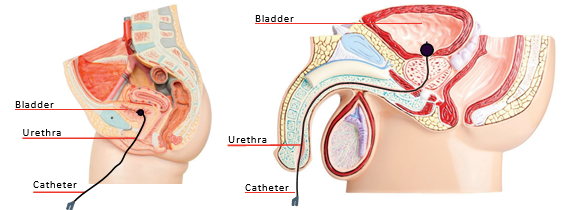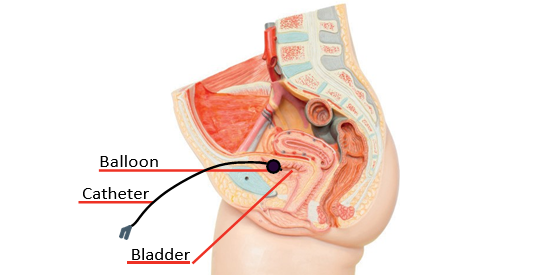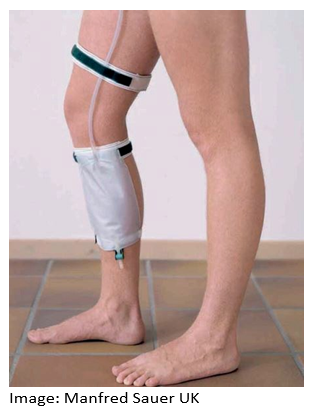A catheter is a thin, hollow, flexible tube inserted into your bladder to drain urine. You will have a drainage bag attached to your leg or around your waist, or a catheter valve and no bag. There are two types of catheter; urethral and supra-pubic.
Why do I need a catheter?
You may need a catheter for many reasons, including:
- to let urine drain if you have an obstruction in the tube that carries it out of the bladder
- to allow you to urinate if you have bladder weakness or nerve damage that affects your ability to pass urine
- to drain your bladder before, during and/or after some types of surgery.
A urinary catheter is only put in when necessary as it carries significant risk of developing UTIs which can be serious or even life threatening.
The information in this guide will help you avoid infections.
If you need more help around caring for your catheter or have any health concerns, contact your GP or community nurse.
Urethral catheter
The catheter is put into your urethra, the tube that carries urine from the bladder to the outside of the body (the opening is at the tip of your penis or just above your vagina). The catheter is put into your bladder, and a small balloon near the end of the catheter is inflated with sterile water to keep it in place.

Supra-pubic catheter
The catheter is put in via a small cut made in the abdomen. This is done in hospital by a doctor, during a short operation using either local or general anaesthetic.

Daily catheter care
Washing
- Wash your hands with soap and water before and after touching your catheter using the method on page 7.
- If possible, have a daily shower (preferably) or bath. Do this with your leg bag or valve attached.
- Wash the skin in the area where the catheter enters the body with unperfumed or mild soap and water at least daily and after using the toilet if possible. Use a clean flannel or cloth for this purpose only.
- Wash the catheter tubing away from the body.
- Avoid using talcum powder.
If you have a urethral catheter:
- Men should be careful to wash under their foreskin, replacing afterwards, unless you have been circumcised.
- Women should always wash the genitals from front to back, to avoid moving faeces from your bottom to the catheter.
If you have a suprapubic catheter:
- Some people may experience a slight discharge from around the catheter site. If this happens then contact your nurse who will tell you the best way to treat it.
- Avoid pulling or restricting your catheter by wearing loose comfortable clothing. Tight clothing can cut off the flow of urine and cause skin irritations.
Correct method of hand washing
It’s important to wash your hands before and after touching your catheter or drainage bag.
Six steps to good hand-washing:

- After wetting hands and applying soap, rub hands palm to palm.
- Rub right palm over the back of the left hand then, swap hands.
- Rub hands together palm to palm with the fingers interlaced.
- With clenched fists rub into the palm of the other hand.
- Using the right hand, rub around the thumb, then, swap hands.
- Rub the tips of the fingers in the opposite palm, then swap hands.
Adapted from the World Health Organisation Clean hands protect against infection.
Securing your catheter
A catheter securement device should be used to stop your catheter tube moving around. This might be a cloth and Velcro® G-strap or a device resembling a dressing that is stuck to your skin. Your healthcare professional will advise you when and how to change this.
Leg bag
Your catheter bag should always be below your bladder; a leg bag can assist you with this.
The leg bag is attached to your calf or thigh by a pair of leg straps, a sleeve, fixation devices or a special holster. How you wear the bag depends on what feels comfortable for you.

When attaching the leg bag using the straps provided, always ensure they are placed through the slots and behind the inlet tube rather than over as this can block the tube.
The choice and size of the bag and the length of tubing depend on where you want to wear it and how much urine you pass. When wearing trousers, a long tube bag may be more convenient as it is possible to roll up the bottom of the trouser leg and access the tap at the base of the bag for emptying urine. Short tube leg bags can be worn on the thigh and are discreet under skirts, shorts and dresses.
Caring for your leg bag
- Wash your hands before and after touching your catheter.
- Empty the leg bag when it is 2/3 full, into the toilet or a dedicated container for transport to the toilet.
- To help prevent infection, only disconnect the leg bag when it is replaced with a new one.
How to change my leg bag
Most leg bags are changed on a weekly basis; it is best to change your leg bag on the same day of the week. Empty the attached leg bag before changing to your new one.
- Wash your hands before and after.
- Open the new leg bag, but don’t remove the protective cap.
- Remove the attached leg bag carefully. Don’t pull or use excessive force.
Men should try to change the position of the leg bag frequently to avoid damage to the penis from the catheter rubbing in one position.
- Point the end of the catheter upwards as you detach the leg bag to prevent leakage. Dispose of old leg bag into a plastic bag (follow your local council’s policy for disposal).
- Carefully remove the protective cap from the new leg bag. Do not touch the nozzle once you have removed the cap.
- Gently insert the new leg bag connector to the catheter. Take care not to touch the plastic nozzle.
Using a valve instead of a drainage bag
If you have a valve attached to your catheter instead of a leg bag, you should open the valve to empty your bladder:
- every three to four hours during the day
- when you feel your bladder is full
- before opening your bowels.
A valve may not be recommended for certain conditions. You will be advised by your healthcare professional.
To help prevent infection, only disconnect the valve weekly when it is replaced with a new one.
Attaching a night bag to a valve is optional. If you do use a night bag, remember to open the valve to allow urine to drain into the night bag.
The night bag
Night bags allow free drainage of urine when in bed.
- Attach a night bag to the leg bag or valve.
- Open the tap from your leg bag.
- In the morning close the leg bag or valve.
- Remove the night bag and empty the urine into the toilet.
- Dispose of empty night bag into a plastic bag (follow your local council’s policy for disposal).
Is it possible to have sexual intercourse with a catheter inserted?
Yes, it is possible. A suprapubic catheter may make it easier, speak to your healthcare professional for more information.
If during intercourse you experience any pain or discomfort, you should stop. Talk to a healthcare professional about any concerns you have.
Before:
- wash your hands before and after touching your catheter
- empty your bag.
Advice for men
- Once erect fold back your catheter along the length of the penis, leaving a loop. This will stop the catheter pulling.
- Apply a condom to help secure the catheter.
- If you need a lubricant use a water-based gel.
Advice for women
- Secure or tape your catheter out of the way.
- After intercourse clean your genital area thoroughly with warm water and unperfumed soap.
Healthy bladder and bowel
Maintaining a healthy bladder and bowel is very important. A full, constipated bowel can press on the bladder and stop the catheter draining freely.
- Drink about 1.5 to 2 litres (about 6 mugs or 8 cups) of fluid in 24 hours, unless clinically advised not to do so. This keeps you hydrated and will help soften your stool and aid easier bowel movements.
- Limit alcohol and caffeine intake as they may irritate your bladder. There is caffeine in tea, coffee, cola, other fizzy drinks and drinking chocolate.
- Eat a balanced, healthy diet.
- Fibre can improve your bowel habit. Eat five portions of fruit and vegetables every day.
- Don’t strain on the toilet. Relax and allow yourself enough time and privacy to empty the bowel fully.
- The colour of your urine may vary as some food or medication can cause discolouration.
Darker urine may indicate dehydration, if your urine gets darker then drinking more fluids can help prevent infection.
Troubleshooting
If you are worried about your urine, or that your catheter is leaking/not draining, here are some checks.
- Are your food and fluid intake adequate?
- Are you constipated? If you are already following the tips in this guide, seek medical advice.
- Is the drainage bag below the level of the bladder, particularly when sitting in a low or reclining chair?
- Is the tubing twisted, or restricted by tight clothing?
- Is the tubing extended or pulled tight towards the bag?
- Is the catheter tube connected to the drainage bag correctly?
- Are the leg straps stopping urine flowing into the bag?
- Is the bag too full? If in doubt empty the bag.
- Change your position and walk around if you are able and it is safe.
- If your catheter is leaking but still draining some urine, this may be due to bladder spasms—where the bladder contracts as a result of irritation from the catheter. Sometimes patients who have bladder spasms can be treated with medication, speak with your healthcare professional.
Seek help if:
- Your catheter is draining little/no urine despite adequate fluid intake and following the troubleshooting guide you feel warm, flushed or shivery, as you may have an infection.
- Your urine has a strong smell, is dark in colour or becomes thick and/or cloudy and does not improve with taking more fluid (if able or advised).
- You experience lower stomach or back pain.
- You have increased stomach swelling with no other cause.
- There is bright red blood in your urine.
- The catheter entry site becomes red and sore.
- You have bleeding into or around the catheter.
- You have enough urine leaking around the catheter to make your clothing wet and you have already followed these self-help measures.
- Your catheter falls out.
Urinary tract infections
How will I know if I have a UTI?
Having a catheter in your urinary tract significantly increases your chances of getting a UTI, which is why it is so important to care for it following the advice in this passport.
Signs and symptoms associated with a UTI:
- Feeling unwell.
- Fever with or without uncontrollable shaking.
- New pain at lower tummy or back.
- Becoming agitated or newly confused.
- Pain around the area where the catheter is put in and/or pus like discharge in the urine.
- Unusual tiredness.
How is my UTI treated?
- A urine sample should be taken from your catheter sampling port and sent to microbiology.
- You may be started on an antibiotic.
- Your catheter should be changed.
- You should make sure you are drinking plenty of fluids.
Proper use of antibiotics
- Make sure you follow the instructions given with the antibiotic and finish the course.
- Using antibiotics only when we need to helps reduce the chances of bugs causing the infection becoming resistant to them.
- This helps protect our antibiotics so we can rely on them to work when we really need them.